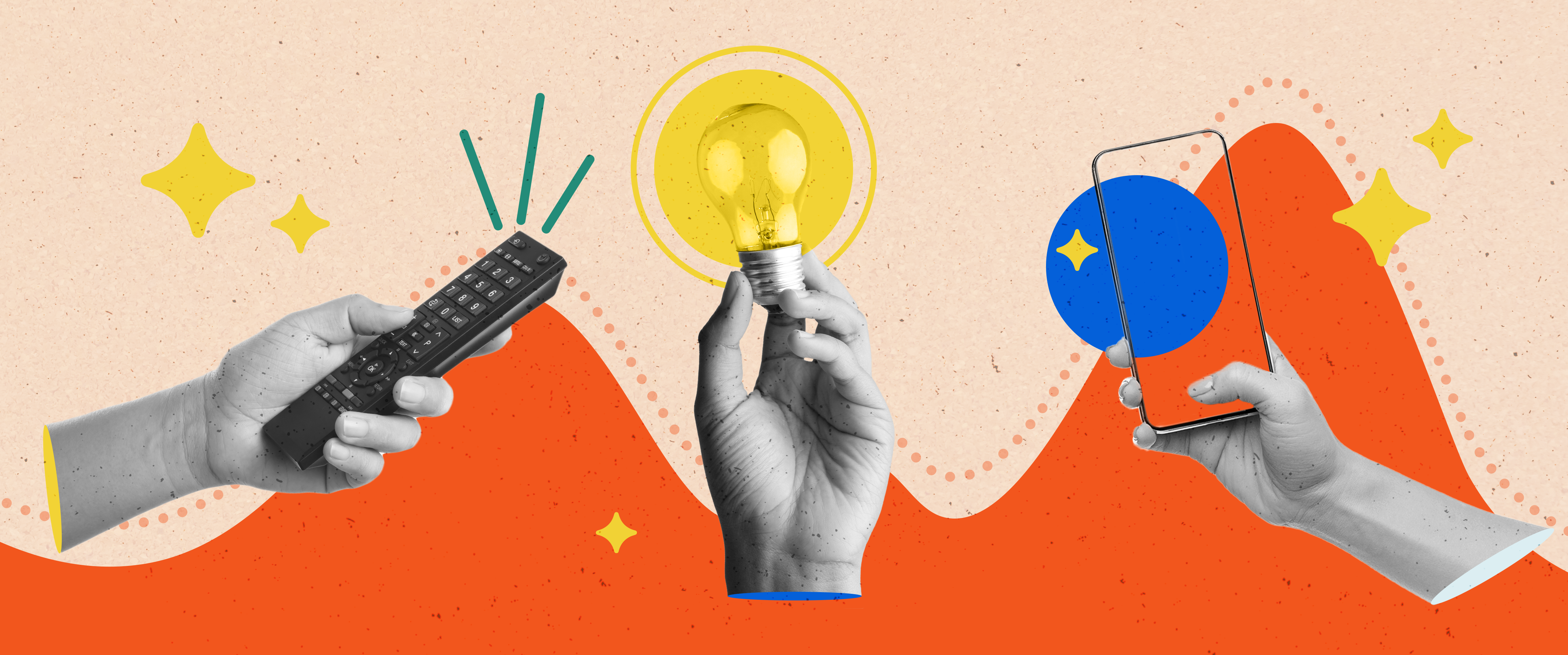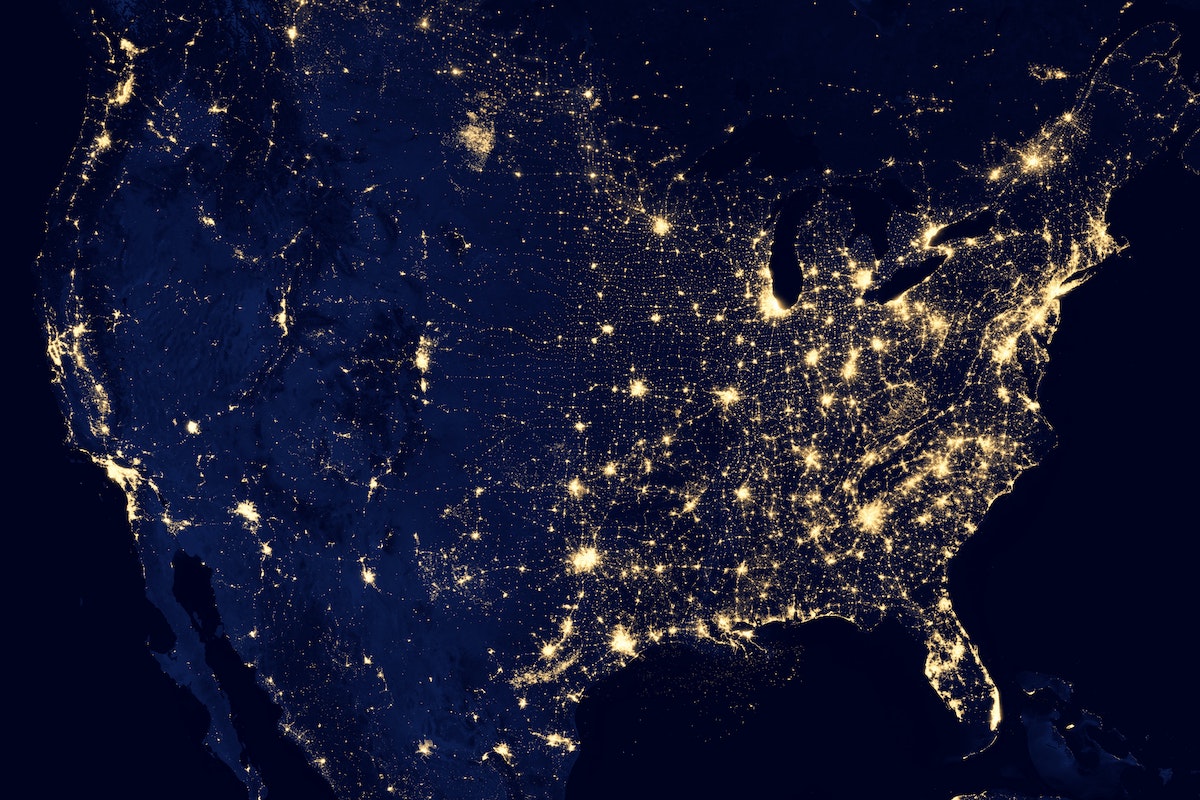Advertising and analytics have changed drastically in the past few years, especially in 2020. This series, “The State of Advertising and Analytics,” explores the evolution of media, advertising and privacy, the rapid growth of data analytics in marketing, and the future of marketing and analytics, providing useful tips and value along the way. Read the first, second, and third chapters.
***
Advertising has moved from traditional, to digital, to hybrid placement. Analytics has gone from reading off numbers to full-blown predictive engines that help advertisers bid smarter and make ads more effective. We know the lay of the land, but where does it go from here? What could possibly improve or change in the next five, ten, or fifteen years to reshape the industry?
In the future, this map will light up a whole lot more for advertisers.
Media and advertising
The past decade centered around the mobile revolution and connected devices. Radio went to smart speakers, TV went to OTT, and if your website isn’t mobile-friendly, people probably won’t buy your product. Despite how cemented these changes have become and how they appear, there’s plenty of room left to revolutionize the space.
First, let’s discuss audio. It remains the only medium with directly attributable reach to struggle with sustained value. Streaming audio will surpass over-the-air listenership in the very near future, if it hasn’t already. Smart speakers will likely weave their ways into vehicles in an intuitive way that bridges the gap for measurement, which is the primary place over-the-air dominates. Unfortunately for radio, major phone companies don’t appear to be activating or including AM/FM transmitter chips, let alone finding ways to implement measurement, so they’ll either need to flip the value on over-the-air ad inventory, or find a widely adoptable solution. Once major players in the space solve for real, tangible measurement instead of relying on estimates, audio will become the powerhouse it deserves to be.
TV, and video more broadly, appears to have figured itself out faster, but linear TV continues to be siloed outside of digital measurement. As new devices become more prevalent, tech will find ways to capture and pass back non-OTT and non-cable data, such as time and length of viewership on specific channels, which can then be converted into rich behavioral segments available for advertising. Similar to audio, manufacturers need to build these measurement capabilities and tech into their devices, which will then make the medium infinitely more valuable.
Out-of-home and experiential advertising has seen a lot of innovation in recent years, like digital bus stops/info kiosks, rideshare retargeting and geo-farming (audiences built from an event location over time), but there’s so much more to see. Major players will find creative hyper-targeted solutions that help conferences and expos maximize sponsorship awareness. Virtual watch parties emerged from the pandemic as a way to create co-watching experiences across the world, and those will likely play a huge role in the development of the Metaverse. Augmented reality has a huge opportunity to enhance this category, and it will be exciting to see what kinds of layers brands will build into their marketing efforts around cities. 5G will enable this medium to develop and grow, so be sure to keep an eye out.
Lastly, and certainly not least, digital advertising will see the most drastic shifts. There will likely come a day when the social media giants band together to open up advertising inventory at scale, similar to how programmatic advertising democratized ad spend across blogs and websites. This bet is hedged on the strong possibility of federal regulation, which will either break up the companies or force them to separate their ad business from inventory. Privacy initiatives will push brands to focus harder on deterministic (or first party) data solutions, contextual categories, interests and website behaviors. This might drive data management platforms (DMPs) to band together for some style of unified behavioral offerings, like “people likely to purchase,” without being tied to individual user data, thus enhancing both consumer and advertiser experiences.
Analytics
With great data comes great responsibility. Advertising channels already have boatloads of data coming through, either from the platform (Facebook collecting user behavior data), from the bid stream (the real-time auctions taking place to win impressions behind every visible post in a user’s feed, on a website, app or audio stream), or the generated data from machine learning to enhance all of these things. This collection of data has enhanced the front end of advertising, but what about the back end?
Brand-owned experiences are, and will continue to be the central focus in the future. A company website is where users can immerse themselves to learn more without external influence, so it’s natural to give weight here. A decade ago, websites with poor experiences could scrape by, since design and measurement tools hadn’t yet caught up with internet usage growth. Now, User Experience (UX) design and quality control are key to retaining a consumer base with an ever-shrinking attention span, and the focus will shift from a beautiful art piece to a beautiful art piece that serves form and function.
The advent of Google’s latest iteration of web analytics, GA4, is a testament to this shift. Event-based measurement (where every single action can be recorded, not just pageviews or button clicks) will be the new gold standard for understanding consumer behavior, adapting websites to enhance the journey, adapting advertising to drop users into the perfect point in that journey, and adapting media plans to serve the journey beginning to end.
Another evolution, or revolution, will be in the open-source realm. As more companies refuse to bend to FAANG (Facebook, Amazon, Apple, Netflix, Google) and their products, web developers are building free-to-use versions of applications that either do the same work, or are increasingly flexible to allow smaller brands the opportunity to build proprietary systems. If a website blows through the data limits imposed by Google Analytics’ free version, a company can implement a tool like Snowplow to absorb the workload, without shelling out hundreds of thousands of dollars for GA360 or a similar scaled-up analytics tool. Simply hire a developer or have experience in coding language, and you’ll have a custom solution running quickly. Open source tools are available for everything outside of the ad bidding itself, and will likely remain that way as the ad bidding ecosystem has been extremely volatile and expensive to build on over the past decade.
With media buying and advertising, understanding the gap between when a user clicks on an ad and where they take an action or make a purchase is crucial, and it will no longer suffice to report on just impressions, views, engagements and clicks. Reports will shift from PowerPoint slides manually put together, to real-time dashboards that give total insights across channels, to simplified reports that boil all the data down to grades or scores telling a much faster, more complete story of a campaign. Brands as a whole will rely less on external “benchmarks” and more on internal performance, since no two brand strategies within an industry are the same.
Merging all of this data and connecting the dots will open up new jobs in agencies tailored to data analysis, science and engineering, which will ultimately shift the service model from advertising management to analytics management. This shift is already heavily apparent, as more platforms build self-service tools, the desired skills of an agency rely less on setup and execution, and emphasis of work scopes leans more on results and analysis.
Finally, creative teams supported by a properly sourced analytics engine will see the fruit of their work harvested in new ways. With teams empowered to create and iterate based on data-driven results, artwork and copy will become more tailored than ever to serve customers better, strengthening client-brand relationships and helping everyone win big.
Putting it all together
Attention wins. Facebook became a powerhouse because it grabbed attention. Google was easy to use and remember, and built on the attention it received. It’s no wonder brands trust billions each year to these platforms, but it’s key to consider that they’re not the only players on the team.
Traditional mediums lost pace because of the red tape between planning, buying and execution. Gate keepers didn’t see how the market shifted, and are now playing catch up to open their platforms to self-service models, or to open up inventory to non-direct partners. TV and radio never stopped being effective — their methods of purchase and analysis just fell out of favor.
Once the industry settles and matures to a point where there’s less friction across all channels, ads and analytics will hit new heights. Platform agnosticism, or the concept that a product (advertising, in our case) performs equally well across platforms, will become the new norm, as brands will choose the most effective channels, not just the most popular. Machine learning has enhanced ad delivery, and will enhance media planning and placement, ultimately enhancing outcomes for businesses. Data is the new oil, and its power will move brands to progress in exciting, efficient new ways.
This series was a huge thought experiment designed to help brands, agencies and consumers understand exactly what they’re living in and where the world is moving, in relation to media and advertising. While this was exciting to write about, ChatterBlast is even more excited to implement some of these future visions as we dive into the 2020s. If you’re a brand interested in evolving, an older agency looking to transition into a new ecosystem, or a company looking for a fresh take on marketing, reach out for a conversation. We’d love to chat more and help your team build and grow!




